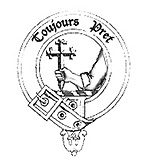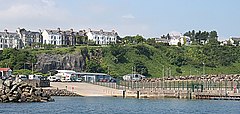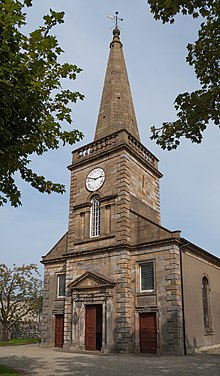
County Antrim is one of six counties of Northern Ireland and one of the thirty-two counties of Ireland. Adjoined to the north-east shore of Lough Neagh, the county covers an area of 3,086 square kilometres (1,192 sq mi) and has a population of 651,321, as of the 2021 census. County Antrim has a population density of 203 people per square kilometre or 526 people per square mile. It is also one of the thirty-two traditional counties of Ireland, as well as part of the historic province of Ulster.

Rathlin Island is an island and civil parish off the coast of County Antrim in Northern Ireland. It is Northern Ireland's northernmost point.
Somhairle Buíodh MacDonnell, also spelt as MacDonald, was Gaelic chief, the son of Alexander Carragh MacDonnell, 5th of Dunnyveg, of Dunyvaig Castle, lord of Islay and Cantire, and Catherine, daughter of the Lord of Ardnamurchan, both in Scotland. MacDonnell is best known for establishing the MacDonnell clan in Antrim, Ireland, and resisting the campaign of Shane O'Neill and the English crown to expel the clan from Ireland. Sorley Boy's connection to other Irish Roman Catholic lords was complicated, but also culturally and familiarly strong: for example, he married Mary O'Neill, the daughter of Conn O'Neill. He is also known in English as Somerled and Somerled of the yellow hair.

Kintyre is a peninsula in western Scotland, in the southwest of Argyll and Bute. The peninsula stretches about 30 miles, from the Mull of Kintyre in the south to East and West Loch Tarbert in the north. The region immediately north of Kintyre is known as Knapdale.

The Mull of Kintyre is the southwesternmost tip of the Kintyre Peninsula in southwest Scotland. From here, the Antrim coast of Northern Ireland is visible on a calm and clear day, and a historic lighthouse, the second commissioned in Scotland, guides shipping in the intervening North Channel. The area has been immortalised in popular culture by the 1977 hit song "Mull of Kintyre" by Kintyre resident Paul McCartney's band of the time, Wings.

North Antrim is a parliamentary constituency in the United Kingdom House of Commons. The current MP is Ian Paisley Jr of the DUP.

Glynn is a small village and civil parish in the Mid and East Antrim Borough Council area of County Antrim, Northern Ireland. It lies a short distance south of Larne, on the shore of Larne Lough. As of the 2011 census, the Glynn ward had a population of 2,027 people.
Randall MacSorley MacDonnell, 1st Earl of Antrim, PC (Ire), rebelled together with Tyrone and Tyrconnell in the Nine Years' War but having succeeded his brother, Sir James mac Sorley MacDonnell, as Lord of the Route and the Glynns in 1601, he submitted to Mountjoy, the Lord Deputy of Ireland, in 1602.

Bonamargy Friary is situated in County Antrim, Northern Ireland, off the Cushendall Road on the approach to Ballycastle. The name Bonamargy means ‘foot of the Margy River’, the river formed by the joining of the Cary River and Shesk Rivers.

Kinbane Castle is located in County Antrim, Northern Ireland, on a headland between Ballycastle and Ballintoy. The name comes from the Irish for "white head", referring to the limestone of the promontory. Nowadays, the castle is largely destroyed. Kinbane Castle is a State Care Historic Monument sited in the townland of Cregganboy, in Moyle District Council area, at grid ref: D0876 4383. The area surrounding Kinbane Castle is a Scheduled Historic Monument, grid ref: D0879 4381. The site also has views of Rathlin Island and Dunagregor Iron Age fort.
The Battle of Glentaisie, was an Irish battle fought in the north of Ulster on 2 May 1565. The result was a victory for Shane O'Neill over the Clan MacDonald of Dunnyveg. The conflict was a part of the political and military struggle, involving the English and occasionally the Scots, for control of northern Ireland. Although the MacDonalds were a Scottish family, based principally on the island of Islay in the Hebrides, they had long been associated with the Gaelic polity rather than the Kingdom of Scotland.

Clan MacDonald of Dunnyveg, also known as Clan Donald South, Clan Iain Mor, Clan MacDonald of Islay and Kintyre, MacDonalds of the Glens (Antrim) and sometimes referred to as MacDonnells, is a Scottish clan and a branch of Clan Donald. The founder of the MacDonalds of Dunnyveg is Eòin Mòr Tànaiste Mac Dhòmhnaill, a son of Iain Mic Dhòmhnaill and Margaret Stewart of Scotland, daughter of King Robert II. Members of the clan actually pronounced and spelled their name M'Connall due to the Gaelic pronunciation of the name Mac Domhnuill thus giving rise to the surname McConnell and its variants. While historically recognised as a clan by the Court of the Lord Lyon, it is now an armigerous clan as it no longer has a chief. The last chief was Sir James MacDonald, 9th of the Clan MacDonald of Dunnyveg or Clan Donald South, who died in London in 1626.

The MacDonnells of Antrim, also known as the MacDonnells of the Glens, are a branch in Ireland of the Scottish-based Clan Donald. Initially part of Clan MacDonald of Dunnyveg, the MacDonnells of Antrim became their own branch in 1558 when Somhairle Buidhe MacDonnell obtained the lordship of the territory in Ireland from James MacDonald, 6th chief of the Clan MacDonald of Dunnyveg. The MacDonnells of Antrim were a sept of the Clan Donald of the royal Clann Somhairle, that the English crown had attempted to cultivate since the early 14th century in its efforts to influence the course of politics in Scotland. The MacDonnells established a growing presence in Ireland throughout the 15th and 16th centuries, and played a crucial role in the politics of 17th century Ireland. The MacDonnell's achieved much success in Ireland largely to cultural and familial connections to the Gaelic nobility of Ireland. Today the surname is predominantly spelled McDonnell in Ireland and abroad, although many McConnells are also of the same family, as that is the Gaelic pronunciation of the Mac Domhnaill. Most of the leadership of the Clan wrote their name as a variant of McConnell up until the 17th century, including Sorley Boy MacDonnell himself. Many of the present-day McDonnells have a common descent from Sorley Boy MacDonnell.

The Antrim Coast and Glens is an area of County Antrim in Northern Ireland, designated as an Area of Outstanding Natural Beauty in 1988.
Dunaneeny Castle is a ruined castle on the outskirts of Ballycastle in County Antrim, Northern Ireland. The castle was home to the chiefs of Clan MacDonald of Dunnyveg and later the MacDonnells of Antrim. The castle is purported to be the birthplace of Scottish-Irish chief Sorley Boy MacDonnell.
Rathlin Castle, also known as Bruce's Castle, was a castle on Rathlin Island off the coast of County Antrim in Northern Ireland.

Causeway Coast and Glens is a local government district covering most of the northern part of Northern Ireland. It was created on 1 April 2015 by merging the Borough of Ballymoney, the Borough of Coleraine, the Borough of Limavady and the District of Moyle. The local authority is Causeway Coast and Glens Borough Council.
James MacDonald, alias McDonnell, 6th Chief of Clan MacDonald of Dunnyveg, Scottish-Gaelic lord, died 1565.
Ballycastle Castle was a castle located at Ballycastle in County Antrim in Northern Ireland.





















